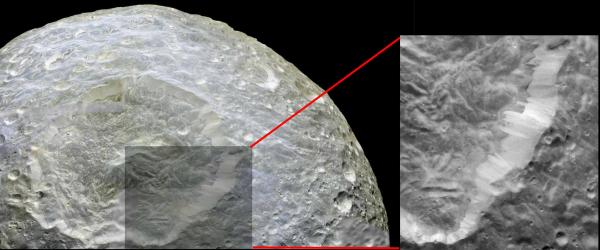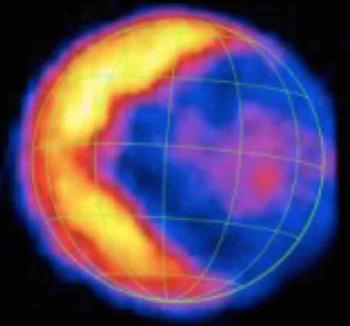Researchers from CEA and Paris-Diderot University think they have discovered the phenomenon behind the exceptional thermal insulation of small icy bodies located beyond Jupiter: an underlayer of amorphous ice water, a few centimeters below the surface. They now understand better why these bodies are unable to store heat from the sun. This work is published in the April volume of the journal Astronomy & Astrophysics.
The role of water ice
A planet or a satellite stores less easily solar heat if its internal heat exchanges are very effective. In this case, the ability to drive or store the solar radiation is low and thermal insulation of the body will be important. Yet, small icy bodies without atmosphere, located beyond Jupiter in our solar system have a significant thermal insulation and furthermore this insulation seems to grow more with the distance from the sun. This behavior is difficult to understand for the scientific community : the farthest are these objectsfrom the Sun (and thus colder), the less they are "responsive" to the heat received and able to store it!
Two researchers from the Department of Astrophysics-Laboratory / AIM (CEA / Paris-Diderot / CNRS) explain these observations by considering the surface structure (porosity, grain size, nature of contacts ...) and especially by examining in detail how heat transfer occurs at depth. They show that this increase of the thermal insulation with the distance from the Sun can be explained if the surfaces are covered with grains composed of amorphous ice water, that is to say, water ice molecules arranged in a disorderly manner (unlike to crystalline ice). The amorphous water ice at these temperatures actually drove less heat than crystalline ice, as would a good insulating blanket. [1]

Left: Mimas observed by the camera of the Cassini probe. Middle: expected distribution of temperature; . Right: temperature measured by the Cassini CIRS-spectrometer [2]., where the front of the satellite in the direction of its orbital motion (right side of image) has lower temperatures and therefore a much greater thermal inertia than the rear face, giving him a profile of "pac-man". Differences in composition, including the variable presence of amorphous ice, can explain these differences in observed temperatures. © NASA / JPL / GSFC / SWRI / SSI.
But there is a "snag." These bodies, located in the outer solar system, are subject to very low temperatures and to the bombardment of high-energy particles, which should well favor the formation of this amorphous ice. But researchers essentially observe only crystalline water ice on the first micrometer of these surfaces. According to astrophysicists, this apparent contradiction is due to the fact that the thermal inertia measurements are probing the first few centimeters deep only. In fact, the layer of amorphous water ice is present, but lower just below the surface, in the first centimeters deep.

Observation of Mimas (back) by the camera of the Cassini spacecraft shows the huge crater Herschel in center. Along the slopes of the crater, massive slump blocks and debris flows are observed which appear as streaks with a different reflectivity (see enlargement at right). The processes that shape these structures are directly related to the ice composition. © NASA / JPL / SSI.
This new thermal model will be used to better characterize the structure of icy planetary surfaces in their first layers and understanding their evolution driven by space weather. The study could thus explain the origin of the dichotomy heat measured at the surface of the satellite Mimas, a synchronous rotation satellite whose front face, the one that is always oriented in the direction of orbital motion, exhibits much higher thermal inertia than the rear face. This research opens also fascinating perspectives to better understand the morphologies and processes that sculpt the icy planetary surfaces, such as along the slopes of the crater Herschel in the heart of the mouth of Mimas "Pacman", where massive slump blocks and debris flows are observed.
Contact : Antoine Lucas , Cécile Ferrari (LADP)
Publications :
" Low thermal inertias of icy planetary surfaces Evidence for amorphous ice ?"
Cécile Ferrari and Antoine Lucas, Astronomy & Astrophysics (1 avril 2016)
For an electronic version : PDF file
see : le Fil Science CEA (2 avril 2016) (in French)
voir aussi : Des dunes du Niger à celles de Titan (29 octobre 2015)
Mers de sable sur Titan (3 octobre 2014)
L'extrême finesse des anneaux de Saturne (1 mars 2013)
Notes
[1] The amorphous ice is an insulator at least 10 times higher than the best polyurethane foam used to insulate the exterior walls of houses. For this reason, the igloos of the Inuit, made of compacted snow, are very efficiently isolated.
[2] On board the Cassini-Huygens probe, infrared spectrometer CIRS has been in orbit around Saturn since 1 July 2004 after more than six and a half years of interplanetary travel. This spectrometer is the result of collaboration between the CEA-Irfu in Saclay, NASA Goddard Space Center (GSFC) in Washington, the University of Oxford, Queen Mary's College in London and the Observatory of Paris Meudon. This instrument is capable of analyzing the infrared light emitted by the planet Saturn, but also by its famous rings and its satellites. It has a much higher resolution (fine detail) and sensitivity (detection of small objects) than its predecessor IRIS, onboard the Voyager probe in the 80s.
Rédaction : A. Lucas, C.Ferrari, Jean-Marc Bonnet-Bidaud




